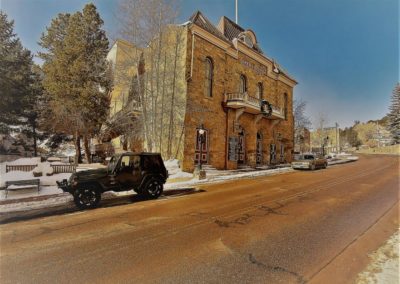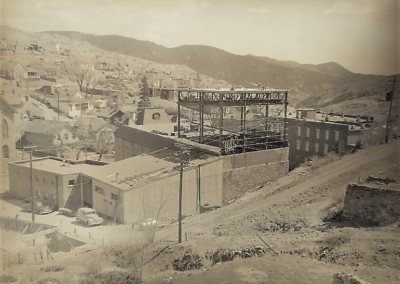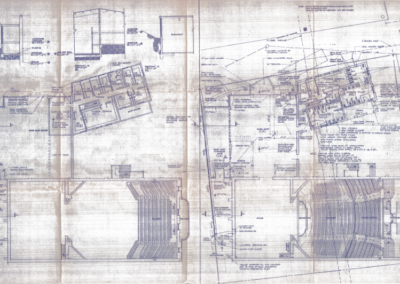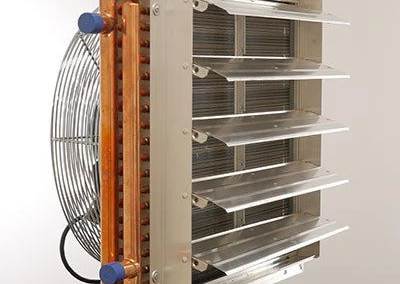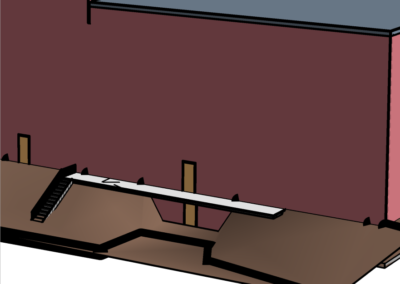F20-19.1 Central City Opera House Heating/Ventilation System
Overview
This project challenged a team of engineering students to design a heating system for the Central City Opera House. The solution needed to render the opera house functional during the Central City winters, while respecting the historic nature and construction of the building.
Beyond the thermodynamics of this project, several challenges inherent to working with a nearly 150-year-old building presented themselves throughout the process. The Team needed to balance system performance with concerns over aging architecture, historical preservation, and limited space.
The Team divided the building into three distinct heating zones, while all zones required an insulation package to improve their heat retention, each zone required a unique heating solution. While the Team had a thermodynamically viable solution early on, struggles with constructability, such as meeting building code requirements related to access and egress, presented themselves throughout the project. The Team worked through multiple design iterations before arriving at a set of solutions that meet all the social and technical requirements. These solutions employed a combination of forced hydro-air, hydronic, and gas fired heating systems which will allow the opera house to be heated from 0 to 70 degrees within 48 hours.

Live Zoom Chat
Use the link below to join us live from 8:00 – 10:30 a.m. on December 3.
Please use passcode: 078900
Or iPhone one-tap: 16699006833,94156388530# or 12532158782,94156388530#
Or Telephone:
Dial: +1-669-900-6833 (US Toll) or +1-253-215-8782 (US Toll)
Meeting ID: 941 5638 8530
Team Members
- Rion Gipson-Hansen
- Hunter Hodge
- Nicholas (Nick) Kistler
- Connor Stutsman-Plunkett
The Client
- Eric Chin
- Scott Dessens
- Pat Pearce
- The Central City Opera House Association
Acknowledgements
Project Advisor:
Antonie (Tony) Vandenberge
Technical Advisors:
Professor Chris Coulston PhD.,
Professor Paulo Tabares-Velasco PhD.,
John Toussaint
Donations Made by: None
Video
Elevator Pitch
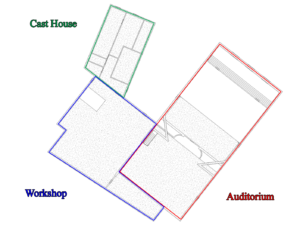 The Central City Opera House is the cultural heart of Central City, yet it can only operate in the summer due to the bitter cold. The student design team was tasked with designing a heating system to allow operation year-round. While the opera house is old, construction has been ongoing, and each region have very different properties. The Team identified three different areas, and each received a unique heating solution.
The Central City Opera House is the cultural heart of Central City, yet it can only operate in the summer due to the bitter cold. The student design team was tasked with designing a heating system to allow operation year-round. While the opera house is old, construction has been ongoing, and each region have very different properties. The Team identified three different areas, and each received a unique heating solution.
The auditorium requires a huge amount of heat and will be serviced by two boilers and 4 air handlers. These along with supporting equipment such as pumps and reservoirs will be located in the only available space: the crawlspace beneath the seating area. To avoid the complications inherent in bringing the entire crawlspace up to code, a smaller equipment room will be constructed within it. The workshop requires only one boiler, but has no space for equipment, so its systems will share the crawlspace equipment room. Routing ducting to the workshop is infeasible, so instead, hot water will be pumped to suspended hydronic heaters on the workshop ceiling. The cast house is already outfitted with a roof top air conditioning unit and supporting ducting. However, the unit itself has exceeded the end of its useful life, so the Team has recommended a replacement that will add heating functionality.
To increase the effectiveness of the heating system, an insulation package was recommended which included lightweight spray foam insulation for the auditorium attic and workshop ceiling, replacement doors for all but the main entrance, and a large insulating curtain for the workshop service door. The main entrance and windows are historically relevant, so artisan door restoration and custom window inserts will be required.
Design Approach
Definition of scope was a critically important aspect of this project. To help focus the Team’s efforts, the deliverables for this project were determined to be:
- Develop a calculation package sufficient to thermodynamically model the opera house
- Select equipment and renovations that together would provide adequate heat to the opera house throughout the year
- Determine operating and maintenance costs to assess system feasibility
- Draft a set of mechanical drawings that can be bid upon by contractors
Additional considerations such as bringing work areas up to Gilpin County building code, asbestos detection and remediation, flood control, and funding sources were beyond the scope of the project.
Renovation construction projects such as this have a laundry list of constraints that must inform the design process, not all of which were apparent at the outset of the project. Some of the primary factors that influenced the design were:
- Minimizing the long-term costs of the project
- Ensuring the system was sufficient to operate in all reasonable weather conditions
- Regulations preventing equipment from being visible from the main street
- The value of the usable workshop floorspace
- The ownership status of land behind the opera house
The Team began the design process by quantifying what the system needed to be able to accomplish. Given that the existing opera house heating system was wholly ineffective, the Team created a hypothetical scenario that the new heating system would need to be able to handle. The scenario involved heating the opera house interior to a comfortable 70ᵒF from a 0ᵒF starting temperature in under 48 hours, all in consistent 0ᵒF weather.
To translate this scenario into a set of design specifications, the Team created a mathematical model of the opera house that captured how it loses and stores heat. This gave the Team two important numbers, the heat flow required to maintain a temperature inside, given a temperature outside, and the amount of heat flow required to increase that temperature, given an amount of time.
With the target specifications in sight the Team began an iterative design process. During each iteration, the Team conducted research and preformed modeling to gain additional information about the problem. The Team would then use this information over the course of several meetings and brainstorming sessions to refine the system requirements. From there, the Team researched equipment that better fit the requirements. The Team then collected the equipment into a coherent design and presented it to our clients and industry professionals. Finally, the Team received feedback on the design, and began work on the next iteration. Every time this process was conducted, new engineering challenges came forward in the form of technical limitations, client requests, and physical limitations. Several version of the design were created before one that satisfied the concerns of both our clients and industry professionals was compiled.
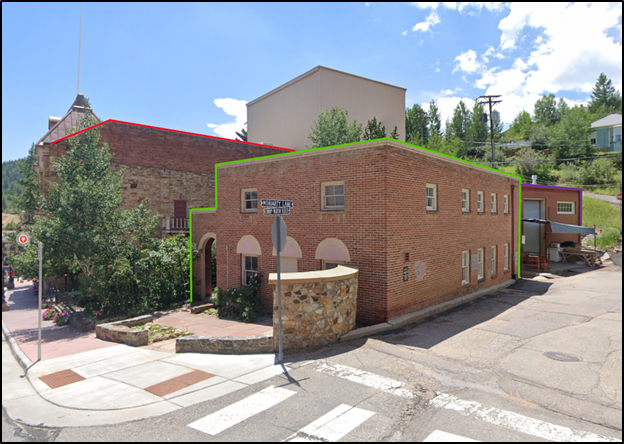
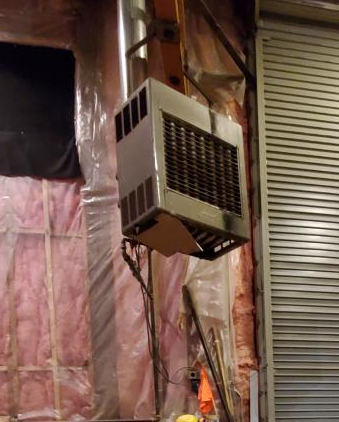
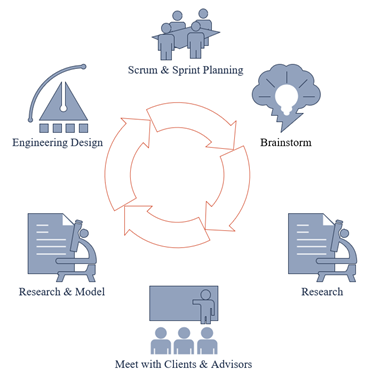
Design Solution
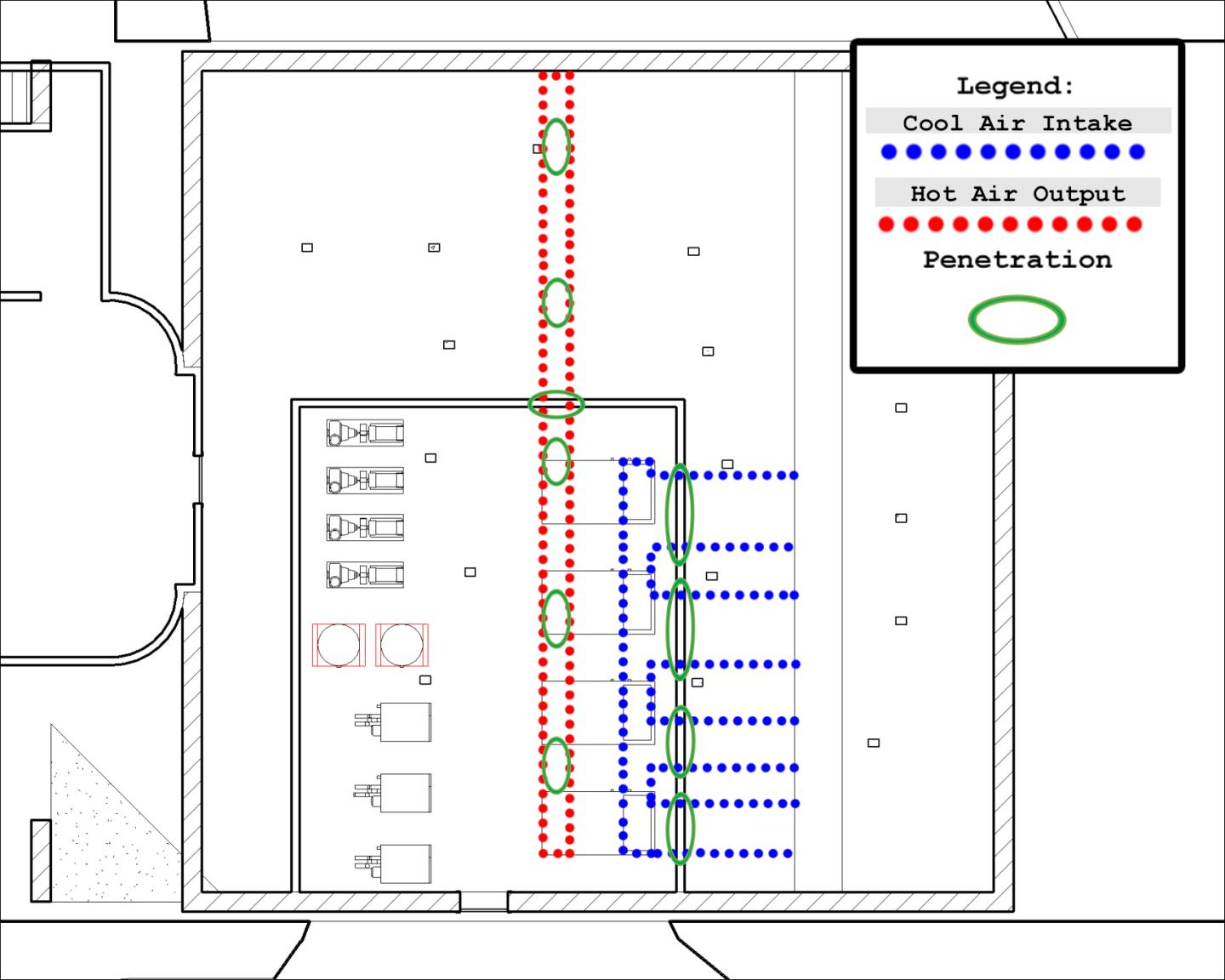
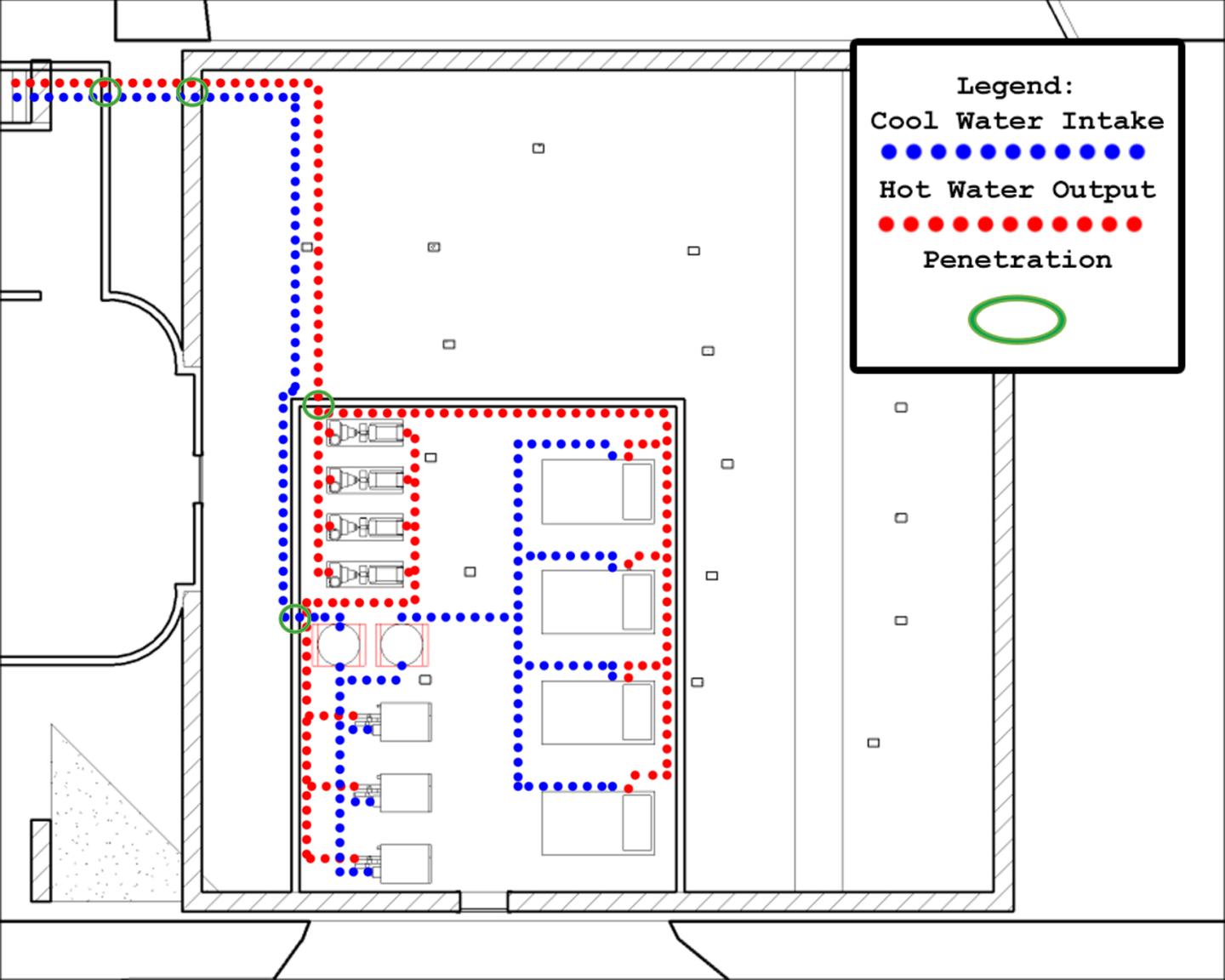
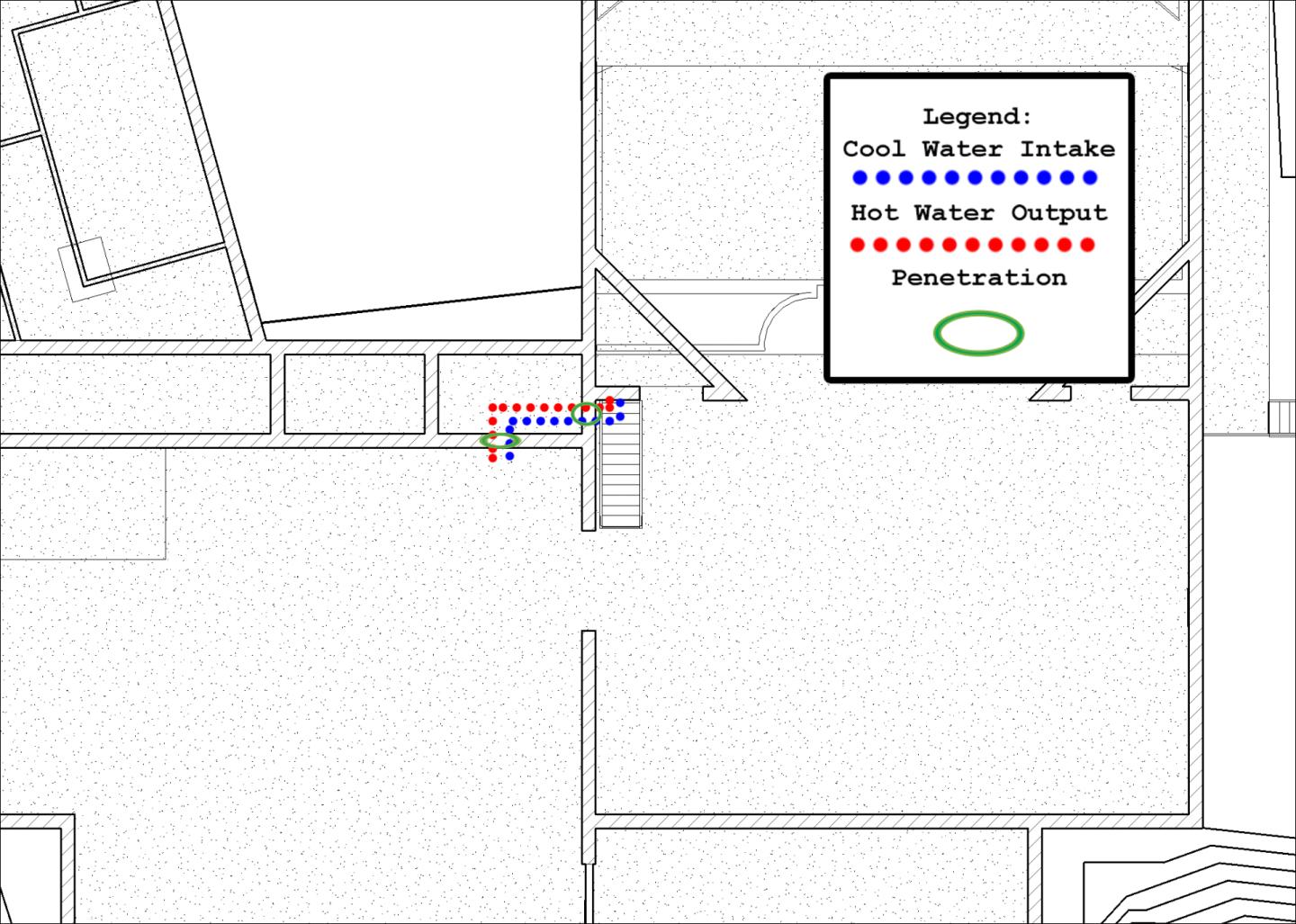
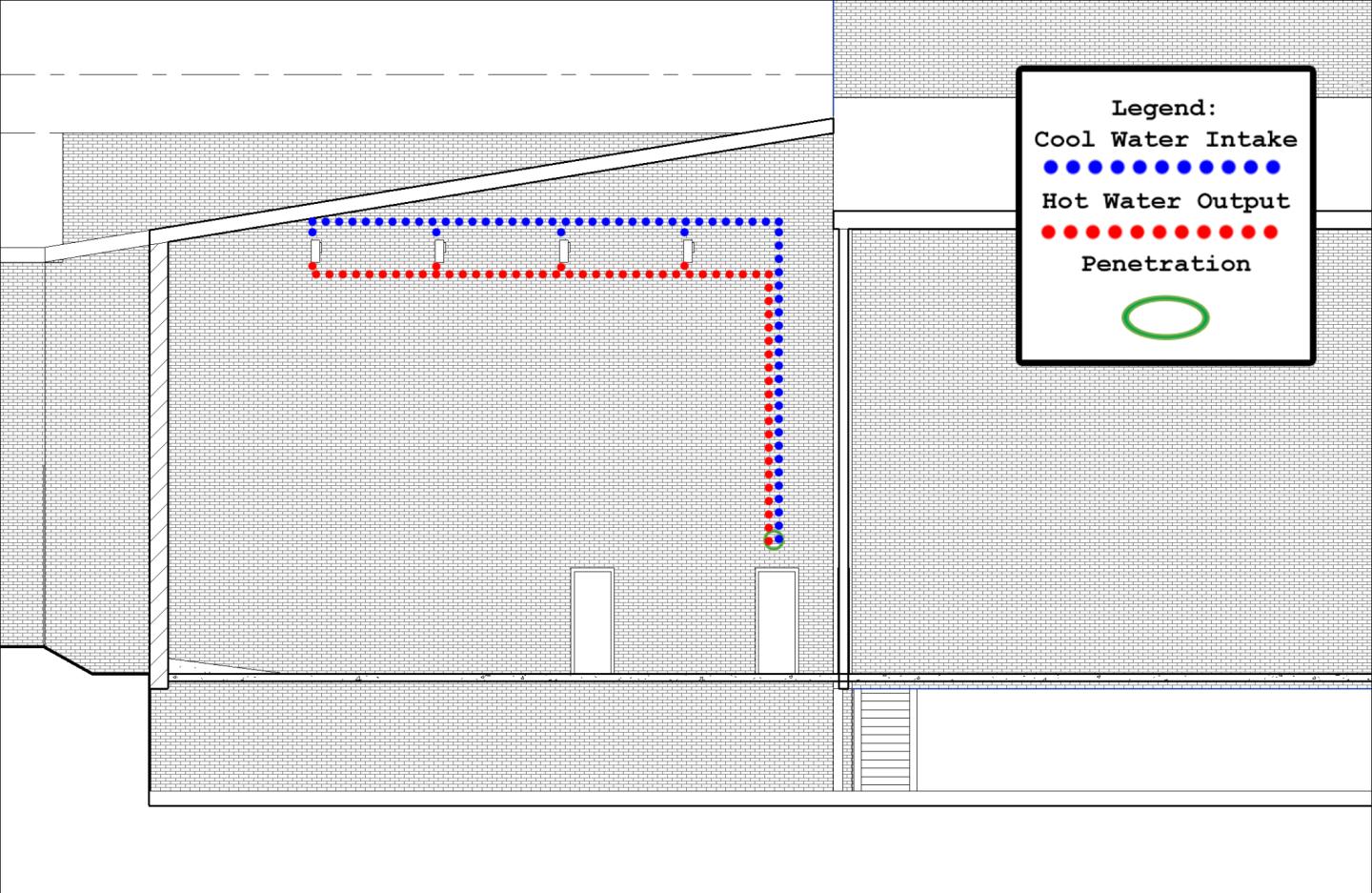
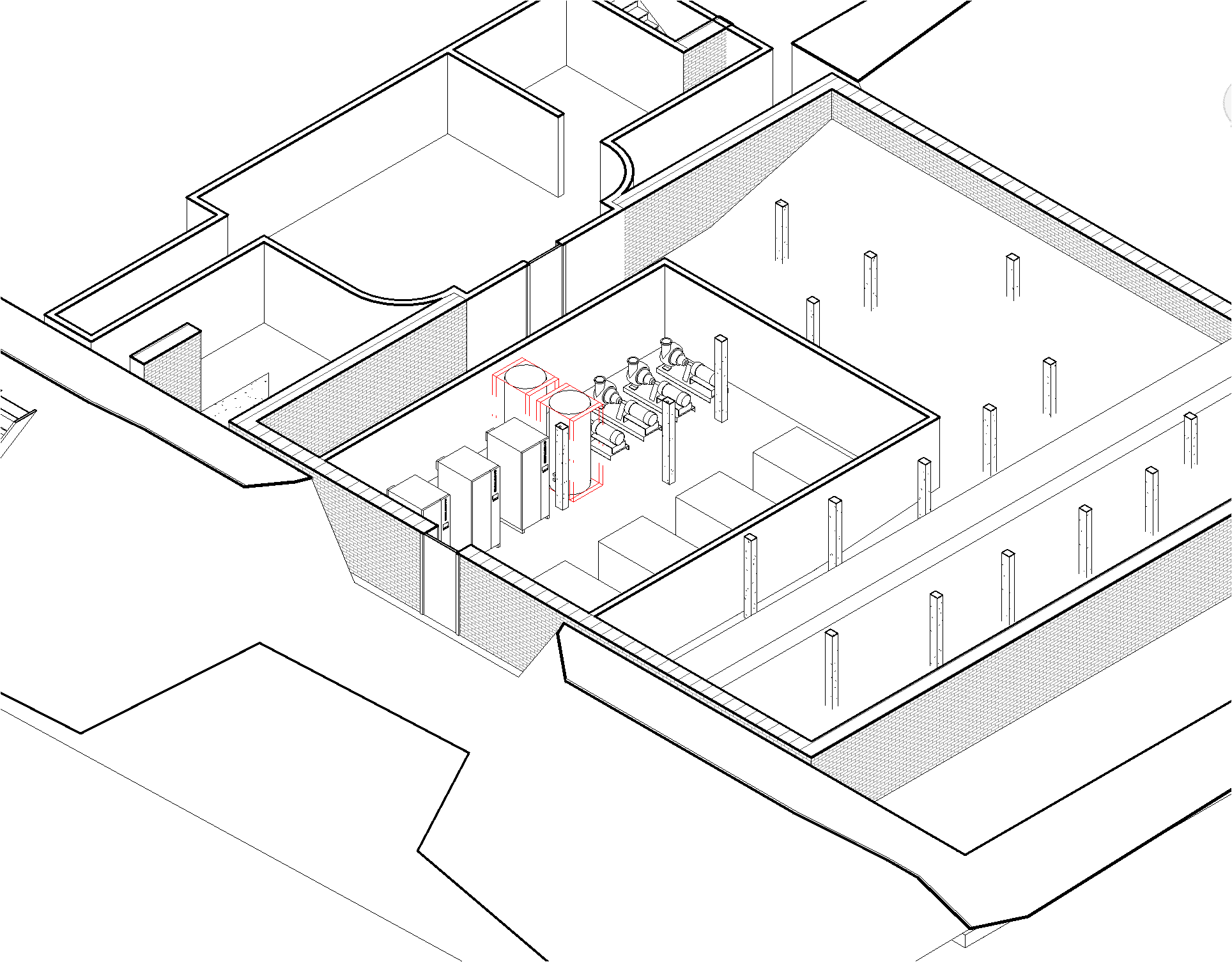
The Team explored multiple options for equipment, locations, and heating methods. After exploring all other options and many conversations with the client, the Team determined that the only suitable place to locate the equipment was underneath the seating area in the crawlspace. This meant that heating the auditorium was comparatively easy, By routing forced air strategically into the auditorium through the floor and tapping into an existing rear duct to allow for recirculation, the auditorium zone can be handled by a self-contained hydro-air system.
The heart of the first system would be a set of two Laars MagnaTherm HTD 2500 water heaters, which would generate the required heat. For the warm water to deliver heat to the auditorium, it needs to be passed through a heat exchanger, which will transfer the heat from water to air. To force the hot water through the heat exchanger, a pair of pumps are required. The Team recommended Gould Water Technology’s e-MPA group pump to fill the role. To Force air across the heat exchanger and cycle air through the auditorium, air handlers are required. The team determined four Carrier 39MN25W air handling units would be up to the task. To remove reliance on the opera house’s inconsistent water supply and keep the system functioning, a 500-gallon reservoir will be added to the system. The Team suggested an Ace Roto-Mold VT0500-46B vertical storage tank for this purpose.
With the auditorium handled, the workshop was next up on the agenda. While the Team originally wanted to create a similar system to handle this zone, the clients strongly preferred for the workshop to lose none of its current work/storage space, as that would inhibit their ability to conduct two simultaneous productions. To address this preference, the Team considered creating an external structure to house the equipment, but after conducting research and speaking with technical advisors, the technical, legal, and financial difficulties associated with this option made it prohibitive. On advice from technical advisors, the Team perused a hydronic heating strategy. Hydronic heaters are smaller than air handlers, and don’t use ducting. Rather they consist almost entirely of a heat exchanger and a simple fan. This smaller form factor allows them to be suspended from the workshop ceiling. Of course, this still left the problem of where to put the heat source. The only remaining option for equipment storage was the crawlspace under the seating area, so the Team decided to pipe the hot water from there to the workshop through a series of wall penetrations. The basics of this system are the same as the previous one, but some specifics are different. To generate the heat, another Laars MagnaTherm HTD 2500 water heater was chosen. To transport the warm water, two of Gould Water Technology’s 3656/3756 S group pumps were selected. To distribute the required heat, 8 Dayton 1EBC3 Horizontal hydronic heating units will be necessary. Like the previous system a reservoir will be necessary, and the Team again recommends an Ace Roto-Mold VT0500-46B vertical storage tank.
This just leaves the cast house. Earlier in the project’s development, the Team had been exploring things like adding a heat exchanger to the existing roof top air conditioning unit or tapping into the existing ventilation for a forced air solution, but none of the Teams plans had really stuck. The Team hit upon a spot of good luck fairly recently though. Upon review of a report that was conducted over the summer by an outside engineering firm, Marx | Okubo Associates Inc., it was found that the existing roof top air conditioning unit was nearing the end of its useful life and required replacement anyway. This allowed the Team to search for and recommend a new comprehensive unit that could handle both air conditioning and heat through the simple addition of a gas line. The Team recommended a roof top unit with a direct exchange (DX) cooling coil and heat exchange (HEX) – RT-PRC077E-EN – 7.5 Ton system to handle this task.
In addition to the selected equipment and location, other challenges presented themselves. In order to improve the effectiveness of the heating solution to acceptable levels, the Team needed to address the huge amount of heat leaking out from the opera house through leaks and uninsulated surfaces. The first recommendation the team made here was to insulate the ceilings with polyurethane spray foam insulation; this was chosen because of its effectiveness and light weight. The single pane windows proved more difficult to tackle, as historic property guidelines made replacement impossible. The Team found a solution in “Indows” window inserts; The company has a reputation for helping to sure up old buildings such as Alcatraz Prison, making them a perfect fit. The doors were another issue. While most were not historically significant and could be replaced without issue, the front doors, as per historic guidelines, will need to be restore/replaced by an artist to ensure cultural integrity isn’t lost. The Team’s research led them to recommend Meticulous Restoration in Englewood to handle this.
Finally, an additional challenge presented itself in storing the equipment in the crawlspace. As-is, the space cannot legally house equipment, as it is an enclosed space. To rectify this, the Team has outlined the basics of a new room that will be constructed within the crawlspace, complete with its own legal egress.
Though it took considerable trial and error to reach this point, the Team believes this unique solution will allow the Central City Opera House to attain its goal of year-round operation.
Next Steps
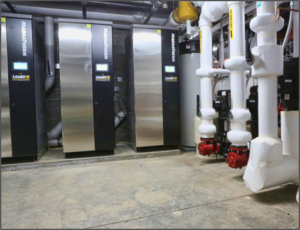 In the event that the project is continued by another group of students, there are some further items that can be expanded upon, especially by civil engineering students or mechanical engineering students with a focus on HVAC. The Teams experience was enough to provide the energy specifications and to select equipment that met those needs but was not able to optimize the actual orientation of the equipment and the layout of both the piping and ducting. While the equipment has been oriented within the room in the crawlspace and there are tentative routes presented in the construction drawings, HVAC students would be able to optimize the layout and the supply lines to the equipment. The drawings present are sufficient to start the bidding process, although further expert layout is advisable.
In the event that the project is continued by another group of students, there are some further items that can be expanded upon, especially by civil engineering students or mechanical engineering students with a focus on HVAC. The Teams experience was enough to provide the energy specifications and to select equipment that met those needs but was not able to optimize the actual orientation of the equipment and the layout of both the piping and ducting. While the equipment has been oriented within the room in the crawlspace and there are tentative routes presented in the construction drawings, HVAC students would be able to optimize the layout and the supply lines to the equipment. The drawings present are sufficient to start the bidding process, although further expert layout is advisable.
Meet the Team
Rion Gipson-Hansen
 Rion Gipson-Hansen is an undergraduate student in mechanical engineering with a minor in computer science, and will be pursuing postgraduate education in the computer science department. His responsibility within the team was the design lead, and he handled the 3D renderings. He was also the scrum master, and as such was responsible for keeping the team on track during daily meetings. His interest in the project was driven by a childhood spent within musical theater productions.
Rion Gipson-Hansen is an undergraduate student in mechanical engineering with a minor in computer science, and will be pursuing postgraduate education in the computer science department. His responsibility within the team was the design lead, and he handled the 3D renderings. He was also the scrum master, and as such was responsible for keeping the team on track during daily meetings. His interest in the project was driven by a childhood spent within musical theater productions.
Hunter Hodge
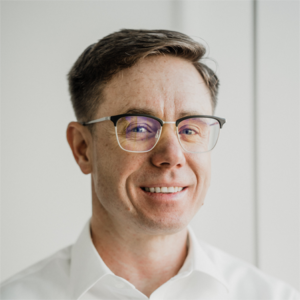 Hunter is a mechanical engineering student from Huntington Beach California. Prior to pursuing his undergraduate degree, Hunter worked as a construction contractor and skilled tradesman in the residential and commercial construction industry. He is a first-generation college student and is interested in helping others realized their dreams of higher education. Hunter enjoys a wide range of activities including surfing, international travel, backpacking, and hiking. After graduation, Hunter will be starting a career in the oil & gas industry as an engineer for Chevron where he hopes to develop the next generation of responsible and reliable energy projects.
Hunter is a mechanical engineering student from Huntington Beach California. Prior to pursuing his undergraduate degree, Hunter worked as a construction contractor and skilled tradesman in the residential and commercial construction industry. He is a first-generation college student and is interested in helping others realized their dreams of higher education. Hunter enjoys a wide range of activities including surfing, international travel, backpacking, and hiking. After graduation, Hunter will be starting a career in the oil & gas industry as an engineer for Chevron where he hopes to develop the next generation of responsible and reliable energy projects.
Nicholas (Nick) Kistler
 Nicholas Kistler is a Graduating Senior in Mechanical Engineering with a minor in computer engineering moving into industry after this semester. Since starting at the school of Mines theater has been a creative outlet for Nicholas and when a project for senior design arose centered around a professional theater it was impossible for him not to jump on it. For this project he applied his knowledge in both areas of study to create mathematical equations and models for the thermodynamic effects of the Opera House.
Nicholas Kistler is a Graduating Senior in Mechanical Engineering with a minor in computer engineering moving into industry after this semester. Since starting at the school of Mines theater has been a creative outlet for Nicholas and when a project for senior design arose centered around a professional theater it was impossible for him not to jump on it. For this project he applied his knowledge in both areas of study to create mathematical equations and models for the thermodynamic effects of the Opera House.
Connor Stutsman-Plunkett
 Connor Stutsman-Plunkett is a senior in the Electrical Engineering and Computer Science departments, graduating next year. While Connor’s skillset is more suited towards computer engineering, he has a passion for restoring old technology and felt this project was a natural extension of that hobby. Connor helped provide technical support to the Team and served as the communications lead on the project. With this project concluded, the Connor will be moving on to graduate school late next year.
Connor Stutsman-Plunkett is a senior in the Electrical Engineering and Computer Science departments, graduating next year. While Connor’s skillset is more suited towards computer engineering, he has a passion for restoring old technology and felt this project was a natural extension of that hobby. Connor helped provide technical support to the Team and served as the communications lead on the project. With this project concluded, the Connor will be moving on to graduate school late next year.

